HOLLYWOOD FILMS ABOUT JAPAN
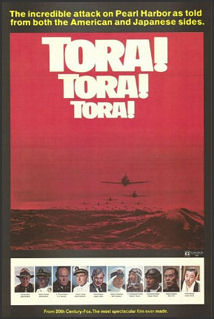
film about Pearl Harbor Hollywood films about Japan include “House of Bamboo”, a film noir feature directed by Samuel Fuller about American gangsters setting up shop in Japan; “Sayonara”, starring Marlon Brando and based on James Michener novel about American servicemen that falls for Japanese girls; “You Only Live Twice”, a James Bond thriller with ninjas, sumo wrestlers and Sean Connery; and “The Yakuza”, starring Robert Michum as a serviceman that returns to Japan to help a friend find his daughter who has been kidnapped by a yakuza boss. “The Yakuza” was directed by Sydney Pollack and featured the actor Ken Takakura practicing kendo.
In the 1944 war-time cartoon “Bugs Bunny Nips the Nips” Bugs Bunny dresses in drag as a geisha and whacks a sumo wrestler — who has fallen in love with the rabbit — on the head with a mallet.
The densely urban areas of Tokyo were the inspiration for the Los Angeles of the future in Ridley Scott’s “Blade Runner”.
The film “Rising Sun” was criticized for portraying Japan as a nation of ruthless, conniving businessmen intent on taking over America. When a Japanese-translation of the Michael Crichton novel, on which the story was based, was released in Japan, the Japanese found the caricatures so preposterous the book was considered humorous rather than insulting. [Source: New York Times]
The cross-country journeys of some films have interesting connections to Japan. The 2010 film “Yellow Handkerchief” with William Hurt is a remake of a 1977 Japanese film “Shiawase bo Kiiroi Hankachi” which in turn was base dn a 1971 shirt story by Pete Hamill that originally appeared in the New York Post and was based on an anecdote Hammil heard in a bar.
Websites and Resources
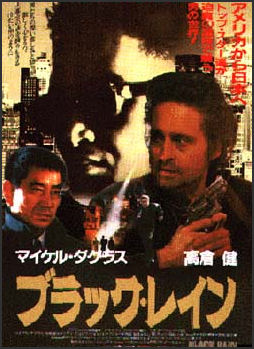
Black Rain Good Websites and Sources: Films on Japan japanvisitor.com ; Hollywoodmania in Japan gmo-research.jp ; Memoirs of a Geisha sonypictures.com/homevideo/memoirsofageisha ; Letters from Iwo Jima iwojimathemovie.warnerbros.com ; Last Samurai Much of “Lost in Translation Sights” was filmed at the Park Hyatt in Tokyo.
Links in this Website: JAPANESE FILM Factsanddetails.com/Japan ; CLASSIC JAPANESE FILMS AND FILMMAKERS Factsanddetails.com/Japan ; AKIRA KUROSAWA FILMS Factsanddetails.com/Japan ; GODZILLA Factsanddetails.com/Japan ; MODERN JAPANESE FILM INDUSTRY Factsanddetails.com/Japan ; MODERN JAPANESE FILMMAKERS AND FILMS Factsanddetails.com/Japan ; JAPANESE ACTORS AND HOLLYWOOD ACTORS IN JAPAN Factsanddetails.com/Japan ; HOLLYWOOD FILMS ABOUT JAPAN Factsanddetails.com/Japan
Books: “A Hundred Years of Japanese Film” by Donald Richie (Kodansha International, 2002); “Japanese Cinema — An Introduction” by Donald Richie (Oxford University, 1990). Good Websites and Sources on Japanese Film: Google e-book: A Hundred Years of Japanese Film by Donald Richie books.google.com/books ; Midnight Eye midnighteye.com ; Japanese Movie Listing lisashea.com/japan ; Kinema Club pears.lib.ohio-state.edu/Markus ; Japan Association for the International Promotion of the Moving Image unijapan.org/en ; Toei Uzumasa Movie Land is a theme park and movie studio were many samurai and historical drams have been shot. Website: Japan Guide japan-guide.com Asian Film Asia Society on Film asiasociety.org ; iFilm Connections — Asia and Pacific asianfilms.org ; Love Asia Film loveasianfilm.com ; Senses of Cinema sensesofcinema.com ; Illuminated Lantern on Asian Film illuminatedlantern.com
Databases, Directories, Links: Internet Movie Database /www.imdb.com ; Directory of Interent Sources newton.uor.edu ; Japanese Film Resources at the University of Iowa lib.uiowa.edu/eac/japan ; Tokyo International Film Festival tiff-jp.net ; DVDs Japanese, Chinese and Korean CDs and DVDs at Yes Asia yesasia.com ; Japanese, Chinese and Korean CDs and DVDs at Zoom Movie zoommovie.com ; CD Japan cdjapan.co.jp ;
Karate Kid
“Karate Kid” was released in 1984. It wasn’t a big box office success but it did well as a video watched on VHS recorders, The film is about a 16-year-old karate student Daniel La Russo (played by 22-year-old Ralph Macchio) who, after moving from New Jersey to California, takes up an interest in the martial arts as a way to deal with a high school bully. He is taught by the wise old Japanese handyman Mr. Miyagi (played by Pat Morita). The film gave the world: 1) immortal phrases as “wax, wax off”; 2) proved the effectiveness of “sweep the leg” karate moves; 3) showed one can practice karate and look like a praying mantis at the same time; and 4) promoted the idea of teaching martial arts by doing tough menial chores such as washing cars and painting fences or impossible tasks such as trying to catch flies with chopsticks.
The Sony-produced 2010 remake of “Karate Kid” opened in June at No. 1 with an impressive $56 million take, the second largest in Sony history . The film stars Will Smith’s 12-year-old son Jaden and Jackie Chan as Mr. Han in the Pat Morita part. Produced by Will Smith, it cost only $40 million to make and was dismissed by the New York Times as “an average romantic comedy that is as soft and sweet as marshmallow, and about as interesting.” In the remake the protagonist learns kung fu rather than karate and moved from Detroit to Beijing. Chan does a credible job in spite of having to deliver some awful lines. Young Smith looks younger than he actually is and his crush on a young violinist comes across a little premature.
Chan got good marks for from critics. He said, “I’m very happy to act in a different role. It’s not just a comedy, but a serious role,” adding that such roles are rarely offered to him.
Hollywood Films About Japan in the 2000s
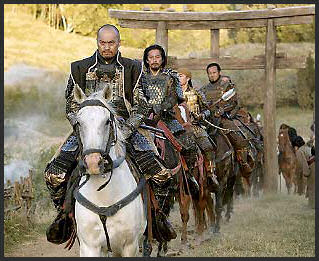
scene from Last Samurai “The Last Samurai”, a film with Tom Cruise shot in New Zealand, features some epic battle scenes but ultimately is disappointing. Cruise plays a civil war hero who is asked to come to Japan to train an army to defeat a group of samurai who refuse to modernize. He is captured by the samurai in a battle and adopts the samurai code. “Last Samurai” is based on “Bushido-The Soul of Japan”, written by Inazo Nitobe in 1899. The Japanese actor Ken Watanabe received Academy Award nomination for best supporting actor. The film grossed $115 million in Japan.
“The Harimaya Bridge” is a film directed by Danny Glover set Kochi Prefecture about an African-American man that comes to Japan to teach English and marries a Japanese woman and dies in a car accident before she realizes she is pregnant with his child.
“Babel”, an Academy-Award-nominated film with Brad Bitt and Cate Blanchett, features one story about a deaf-mute high school girl who is consumed by the suicide of her mother and her desire for sex. Rinko Kikucho was nominated for an Academy Award in 2007 for best supporting actress for her role as the deaf-mute student.
“Tokyo!” is film comprised of three small films about Tokyo, “Interior Design” is a film about the quiet side of Tokyo life by French director Michel Gondroy (“Eternal Sunshine of the Spotless Mind” and “The Science of Sleep”). It is about a couple new to Tokyo who move in with a friend in her tiny one-room apartment. The other two segments are “Shaking Tokyo”by South Korean director Bing Jon Ho about a “hikikiomori” (socially withdrawn person) who falls for a cute pizza delivery girl; and “Merder” by French director Leos Carax, about a human-like creature that emergea from the sewers and takes money from people and eats it.
Japanese Horror and Ghost Films Made Into Hollywood Movies

“The Ring” (2002), an American horror based on a Japanese film, grossed more than $230 million worldwide. The original Japanese film, “Ringu” (1998) was directed by Hideo Nakata and was based on a novel by Japanese writer Koji Suzuki and was a big hit throughout Asia. It was about people who die after watching a video cassette. Many believe the Japanese version was superior to the American one.
Nakata made the Hollywood version for “The Ring 2", which came out in its Japanese version in 1999. The $50 million Hollywood version was released in 2005 and wasn’t as good as the “The Ring” or the Japanese version of “The Ring 2" but still managed to hold the No. 1 spot on the American box office for a week in March 2005. It grossed over $140 million and earned Nakata enough credibility to get the nod to direct the Hollywood version of the Hong Kong horror flick “The Eye”.
Another Nakata film, “Dark Water” (2002) was made into a Hollywood film starring Jennifer Connelly and directed by Walter Sales. Nakata is well known in Japan. His other films include “Chaos” (1999) and “Ghost Actress”.

Describing the Nakata style in “Dark Water”, Anthony Lake wrote in The New Yorker: “There was the jiggle, almost unmatchable sense of something being forever about to spring; there was the tainted use of music, so economical as to border on mean; there’s the nagging ubiquity of unhappy families; and, above all where you looked for blood, there was only water.”
“The Juon” was the first of a series of straight-to-video films written and directed by Takashi Shimizu, a young filmmaker who lot long before the series started was waiting tables in coffee shop and living in a $50 per month apartment to make ends meet. The film is about ghosts of man and his murdered wife and son that haunt a house and serve up trouble to the people that live there. Four Juon films have been released in Japan. They feature discreet use of weird ghosts.
“The Grudge” — the Hollywood version of “Juon” also directed by Takashi Shimizu — was the No. 1 movie in the United States for one week in October 2004. The film stars Sarah Michelle Gellar of “Buffy, the Vampire Slayer” who plays an American architecture students visiting Japan who lives in a haunted house outside Tokyo. The film took in $39.1 million, beating out “Shark’s Tale” for the No. 1 spot, it first week and earned $110 million after two months. The original film was released only on video in the United States but developed a cult following.
Memoirs of a Geisha
“Memoirs of a Geisha”, the bestselling book by Arthur Golden, was made into an English-language film that was popular in the United States and Europe and drew large audiences in Japan, where it was called “Sayuri”, the name of the main character. However it was dismissed by many as Hollywood stereotyped nonsense.
The film critic Roger Ebert said: “I suspect the more you know about Japan and movies, the less you will enjoy “Memoirs of a Geisha”. Those familiar with Japan the film found to be an oversimplified version of Golden’s novel, which in turn was an oversimplified depiction of the geisha world.
“Memoirs of a Geisha” was a real all Asian affair with Chinese actresses with Chinese actress Zhang Ziyi (From “Crouching Tiger, Hidden Dragon”) in the title role as Sakuri, Japanese star Ken Watanabe in the male lead, the Chinese actress Gong Li as Sakuri’s rival Hatsumomo, Malaysian-Chinese Michelle Yeoh as her teacher Mameha and Japan’s Kaori Momoi as mistress of the geisha house where Sayuri worked.
“Memoirs of Geisha” was directed by Rob Marshall, who did the hit musical “Chicago”. There were some rumors that Steven Spielberg was going to direct the film with Madonna in the leading role, supported by an all-Japanese cast lead by Martha Graham dancer Rika Okamoto. That obviously didn’t happen. Spielberg ended up producing the film but deferred on directing it after he became involved in other projects.
Some scenes were shot at temples and other locations in Kyoto, including Kiyomizu-dera temple and Fishimi-Inari Taisha shrine, famous for it hundred of vermillion torii gates, but most of it was shot at a replica of Kyoto’s geisha district — complete with streets, a river and period buildings — constructed on a ranch in Ventura County, California.
See Memoirs of a Geisha, Theater, Geishas
Controversy Over Memoirs of a Geisha
Many Japanese and other Asians were upset about the casting of non-Japanese in Japanese roles. Japanese feel their culture is unique and scoff at the idea of Chinese and other Asians playing Japanese while Chinese and other Asian still carry a lot of ill will towards Japan because of their history and also scoff at the idea of Chinese and Asians playing Japanese. The Chinese director Chen Kaige said, “Japanese culture, as well as Chinese culture has something very profound which can’t be easily expressed....For Hollywood, however does not matter, For them there is no difference between Japanese and Chinese.”
The actors chosen for the lead parts were selected for their familiarity to American audiences and their ability to speak English. The calls for extras for the film called only for “light-skinned Asians.” One Korean-American actress who turned down a supporting role, told the Korean media,”Even if it is Hollywood I don’t wasn’t to start by playing a Japanese geishas. It’s a matter r pride.”
The Japanese media picked apart the film and said it was full of glaring mistakes. They particularly took offense to one scene that showed geishas being whipped, insisting that sort of thing didn’t take place in the geisha world. They also didn’t like the portrayal of a low-ranked sumo wrestler as a high-ranking yokozuna.
Critics of the critics pointed out that the Egyptian Omar Sharif played a Russian in Dr. Zhivago, Englishwoman Vivien Leigh played the southern American Scarlett Ohara in “Gone with the Wind”. Jude Law has played his share of American roles and Johnny Depp had played his share of British ones. In an op-ed piece in the Washington Post, Golden defended they film and his book, saying “It’s worth bearing in mind that “Hamlet” makes poor Danish history and that “Lawrence of Arabia” grossly over oversimplifies the culture of the Middle East.”
The makers of the film said they went through great lengths to make the film authentic. To prepare for the film Zhang and the others went through a six week “geisha boot camp” led by a team of experts. In addition to regular rehearsals they learned how to dance, move like a geishas and play the samisen. Zhang said at a news conference: “We had to learn how to walk, how to bow, how to kneel and how to give a nice tea ceremony, you know, all the small subtle gestures. We had so many things to learn. We tried to give our best efforts.” Yeoh described the seven room where their training took place as “seven rooms of torture.”
Those who want a realist look at the geisha world should check out “Hannari — Geisha Modern”, a documentary by female Japanese director Miyuki Sohara, who spent several years living among geishas and was given access to places and people usually denied by the media. The film includes footage of the ceremony in which a maiko is appointed a geisha.
Letters from Iwo Jima
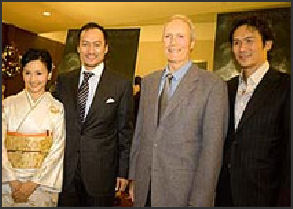
Eastwood and Watanabe at
Iwo Jima reception “Letters from Iwo Jima” was named the best film of 2006 by the National Board of Review. Directed by Clint Eastwood it tells the story behind the battle of Iwo Jima from the perspective of Japanese soldiers, who for he most part faced certain death, and was released in tandem with “Flags of Our Father”, which tells the story of the battle of Iwo Jima from the perspective of American soldiers, who were made into heros.
“Letters from Iwo Jima” is organized around letters written by Tadamichi Kuribayashi — the Japanese general who commanded Japanese forces during the battle and had studied at Harvard before the war. Under his unconventional command, he looked out for ordinary soldiers, protected them against abusive officers and built an elaborate network of tunnels that allowed a garrison that was supposed to fall in five days to hold out for 36. The letters that Kuribayashi wrote were written to his family and discovered by a U.S. marine and published with a survivor’s account in Japan.
The drama is compelling, the acting is good and the battle scenes are spectacular but what make the film really good are the portraits of the Japanese soldiers and the stories of how they deal with their predicament. Some of the characters such as Kuribayashi and Baron Takeichi Nishu — an Olympic gold medaliwinning equestrian rider who befriended Douglas Fairbanks and Mary Pickford and had visions of dying a suicidal death for his country — are historical figures. Others like Saigo — a baker who never fires a shot and wants only to see his family again — are fictional. Other still are composites based on actual people.
New York Times film critic A.O. Scott wrote the film “gets you thinking about war, about defeat, about honor, about duty and takes you closer into the lives of soldiers...than any other war movie.” It is “by a wide margin the best American film of the year.” “It is hard to think of another war movie that has gone so deeply, so sensitively, into the mind set of the opposing side.”
“Letters from Iwo Jima” won the Golden Globe award for best foreign-language film in 2007 and was nominated for an Academy Award in 2007 for best foreign-language film. Watanabe said he Eastwood were better equipped to make the film than a Japanese directors. “If a Japanese director had made this film,” hesaid, “it would have been more sentimental. So Clint could have made the film more objectively. He could show the truth of the tragedy.”
Foreign Films Inspired by Japan

Alain Resnais’s “Hiroshima Mon Amour” (1959) is credited by the New York Times for its “innovative modes of narrative and storytelling.”
“Kill Bill” by Quentin Tarratino features women battling one another with samurai swords, anime scenes, and fights in a Tokyo restaurant and a Japanese garden. Tarratino has credited the Kinji Fukasuku, the king of Japanese violence, with being one of his main influences
“Lost in Translation” is a film about an aging actor (Bill Murray) who is invited to Tokyo to shoot a commercial for a mosque whiskey. In Tokyo he meets a lonely wife of a photographer (Scarlett Johansson). Memorable scenes include Murray shooting the commercial, appearing on a Japanese television show and singing the Sex Pistol’s “God Save the Queen” at a karaoke. The films was shot at the Park Hyatt in Shinjuku and other locations in Tokyo.
“Lost in Translation” won the Academy Award for best original screenplay in 2004. It was directed and written by Sophia Coppola, daughter of Francis Ford Coppola and starred Bill Murray and Scarlett Johansson. Coppola wrote the story based on her experiences in Japan, which consisted of one or two week visits every year for about ten years. She made the film with relatively small budget, which is no mean feet in expensive Japan, and wrote the story with Bill Murray in mind. She labored for months to get Murray to read the script and after he agreed to do the film she wasn’t sure if he would show up in Tokyo for the shooting until he showed up.
“Matrix” was rooted in Japanese manga.
“Black Rain” is a Ridley Scott film about an American police officer (Michael Douglas) in Japan. “Miles and Otis” is a 1989 film made from a Japanese nature film about a cat and dog. Narrated by Dudley Moore, it was an big hit in the U.S. “Hachiko: A Dog’s Story” is an American adaption of the famous Hachiko story with Richard Gere playing the part of the professor.
Foreign Films in Japan
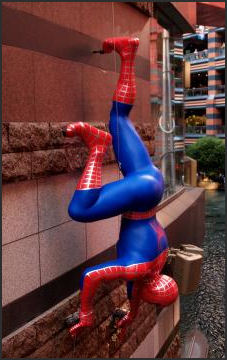
Japan shows about 150 foreign movies a year. Hollywood films usually are the biggest box office successes. Hollywood films that have done week in recent years include the Harry Potter films, “Pirates of the Caribbean, the Da Vinci Code”. Other films like “Syriana, the Omen” and “Eight Below” did poorly and came and went very quickly.
“Titanic” premiered at the Tokyo Film Festival, where legions of schoolgirls lined the streets to catch a glimpse of Leonardo DiCaprio, who was then a teen idol in Japan. The film was a big hit in Shenzhen as t was everywhere in he world and went on to gross $175 million. “Spider-Man 3" premiered in Tokyo. That film and the other Spiderman movies wer ebug money makers for Sony.
Not many foreign films are filmed in Japan because costs are so high. The James Bond film “You Only Live Twice” was filmed in Japan in 1967. No 007 film has been shot in Japan since then. Parts of “The Last Samurai” and “Kill Bill” were shot in Japan.
Sometimes the Japanese names for Hollywood films are very different from the original Hollywood names. Often a great deal of thought goes into choosing a name
Indian films were popular in Japan in the later 1990s and early 2000s, particularly Tamil-speaking lines
Japanese Versions of Hollywood Films
“Sideways” is a Hollywood hit that was remade for Japan. The Japanese version is almost exactly like the original with two guys in the wine country of California expect the two guys are Japanese- and English -speaking Japanese guys in Napa Valley not the wine area near Santa Barbara. It is not a bad film. Paramount is reportedly exploring the possibility of making a Japanese a version of the Demi Moore and Patrick Swayze film “Ghost”. Fox is doing the same with Melanie Griffith’s “Working Girl”.
Explain why they chose “Sideways”, Toru Miyazawa, an executive at Fuji TV, the producer of the film, told the New York Times, “Obviously it doesn’t make sense to remake “Titanic” or “Star Wars”, anything too big.” “Sideways” was good because “it’s a good comedy but not a broad stupid comedy” and good for the targets audience of people in their late 30s and early 40s.
Image Sources: You Tube, Hollywood and Japanese studios via Japan Zone and Japan 101, Ray Kinnane
Text Sources: New York Times, Washington Post, Los Angeles Times, Daily Yomiuri, Times of London, Japan National Tourist Organization (JNTO), National Geographic, The New Yorker, Time, Newsweek, Reuters, AP, Lonely Planet Guides, Compton’s Encyclopedia and various books and other publications.
Last updated January 2013
